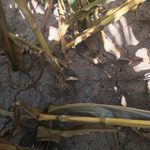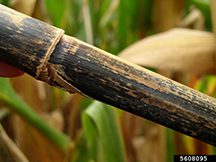By Lexie Maloy
Product Marketing Intern
Harvest may be on the forefront of your mind but don’t look past late-season yield-limiting factors that are still affecting your crop. A wise AgVenture product manager once said, “The crop isn’t yours until it’s in the bin.”
That wise product manager and his colleagues have noticed an uptick in anthracnose stalk rot as they have been studying products in recent weeks. Anthracnose stalk rot has been showing increased pressure in locations that have had moisture stress this year. Before you head out to the field with your combine, get out to the field and look for symptoms of anthracnose stalk rot.
Early stalk rot symptoms are often overlooked. Affected plants will show a shredded pith, distinctive blackening of the stalk rind, and die prematurely. Another common symptom being top dieback, where the stalk above the ear dies four to six weeks after pollination.
The best time to scout for anthracnose stalk rot is from R5-R6 (dent through physiological maturity). Use the “pinch test” to determine if stalk rot is a problem in your field. Randomly select multiple areas in your field and pinch the lowest internode of a few corn stalks in each area. If your pinch test shows more than 10 to 15 percent of the stalks can be pinched, consider scheduling that field for early harvest to try and avoid likely standability issues.
For future crops, anthracnose stalk rot can be better controlled by reducing the inoculum through crop rotation and tillage. (Anthracnose is more prevalent in no-till/reduced tillage fields and corn-on-corn rotations.)
Always consult with your AgVenture Yield Specialist about the disease tolerance ratings of your selected hybrids as you create a cropping plan for 2022 and throughout the entire growing season.


